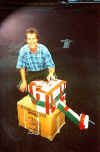
In the summer of 1995, various ozone-profiling instruments from the NDACC (Network for the Detection of Atmospheric Composition Change) were intercompared. Preparations for the program included the construction of a building to house the University of Massachusetts Millitech microwave ozone profiler, installation of the NOAA/NIWA multispectra and UV radiometer system; and preparation of a pad area for two 16.7 m-long National Aeronautics and Space Administration/Goddard Space Flight Center (NASA/GSFC) ozone lidar trailers.
The Jet Propulsion Laboratories (JPL) ozone lidar, also part of the study, had been in full operation at MLO for more than a year prior to the intercomparison. World standard Dobson no. 83, secondary standard no. 65, and the MLO station Dobson were operated prior to, and during, the intercomparison. During a 3-week intensive study period in August, daily ozonesonde launches were conducted from Hilo. Some balloons carried three ozonesondes to determine the variability between instruments.
 |
Bryan Johnson prepares a three ozonesonde package just before flight. |
Ancillary MLO3 measurements included aerosol/temperature profiles with the NOAA lidars, infrared multispectral measurements with the University of Denver Fourier Transform Interferometer (FTIR) spectrometer, and twice-daily measurements from radiosondes launched from Hilo.